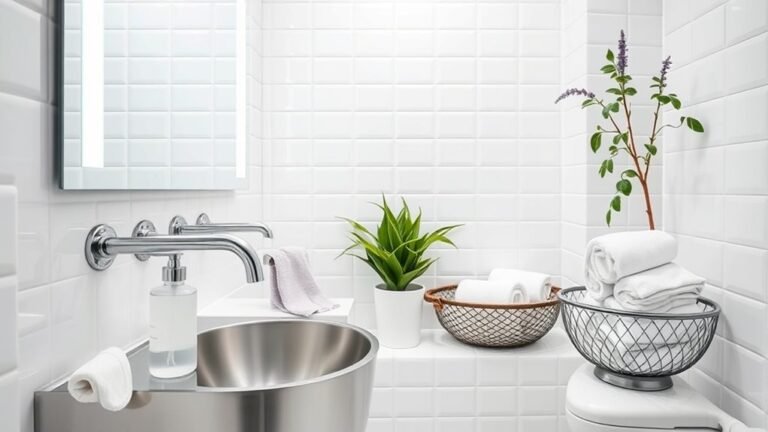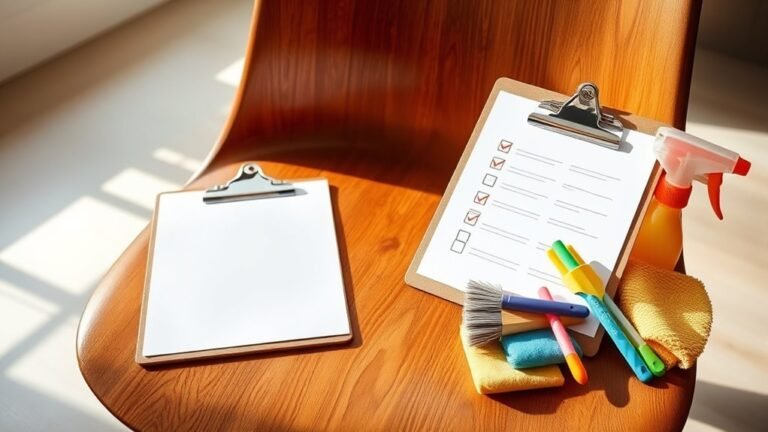DIY Cleaner for Office Chair Surfaces
You can easily make a DIY cleaner for your office chair using white vinegar, water, and baking soda. Mix 1 cup of water with ½ cup white vinegar, then slowly add 1 teaspoon baking soda to avoid fizzing. Put the solution in a spray bottle and gently shake. This cleaner is safe for most surfaces, including fabric and leather with proper care. Keep your chair fresh and stain-free by following simple cleaning and maintenance tips found ahead.
Essential Ingredients for Homemade Office Chair Cleaner

Although there are many commercial cleaners available, making your own office chair cleaner lets you control the ingredients and tailor the solution to your chair’s material. Two essential components are a vinegar solution and baking soda. The vinegar solution, typically a mix of white vinegar and water, acts as a gentle disinfectant and deodorizer, safe for most fabrics and synthetic surfaces. Baking soda complements this by offering mild abrasive properties and effective odor absorption without damaging your chair. Combining these allows you to customize cleaning strength, depending on your chair’s needs. Both ingredients are inexpensive, readily available, and free from harsh chemicals, granting you freedom from commercial product limitations. Understanding these basics guarantees your DIY cleaner is both effective and safe for maintaining your office chair’s surface.
Step-by-Step Guide to Making Your DIY Cleaner
When you’re ready to make your DIY cleaner, start by gathering the necessary ingredients and tools: white vinegar, water, baking soda, a spray bottle, a mixing bowl, and a clean cloth. This simple recipe uses natural alternatives and eco friendly options to keep your office chair fresh without harsh chemicals.
Create a natural, eco-friendly cleaner with vinegar, baking soda, and water to freshen your office chair safely.
- Mix 1 cup of water with ½ cup of white vinegar in the mixing bowl.
- Add 1 teaspoon of baking soda gradually to avoid fizzing over.
- Pour the solution into the spray bottle and shake gently to combine.
You now have a safe, effective cleaner ready to use. This method lets you maintain your workspace with minimal environmental impact, aligning with your desire for freedom from synthetic products.
Cleaning Tips for Different Chair Materials

Since different office chair materials respond uniquely to cleaning solutions, it’s important you adjust your approach accordingly. For fabric upholstery, start by vacuuming to remove dust and debris. Use a mild DIY cleaner applied with a soft cloth or sponge, gently blotting rather than scrubbing to avoid damaging fibers. Allow the fabric to air dry completely. When it comes to leather care, avoid excess moisture that can cause cracking. Use a cleaner specifically designed for leather or a diluted solution of mild soap and water. Apply with a soft cloth, wiping in circular motions, and follow up with a leather conditioner to maintain suppleness. By tailoring your cleaning method to each material, you’ll keep your office chair looking fresh while preserving its integrity and extending its lifespan.
How to Remove Stubborn Stains and Odors
Even with careful cleaning tailored to your chair’s material, stubborn stains and lingering odors can still develop over time. To effectively tackle these, focus on targeted stain removal and odor elimination strategies:
- Apply a mixture of baking soda and water: This paste works well on fabric and some synthetic surfaces. Let it sit for 15 minutes before blotting with a damp cloth.
- Use white vinegar solution: Mix equal parts vinegar and water, spray lightly, and blot to neutralize odors and break down tough stains.
- Try an enzymatic cleaner: Ideal for organic stains and odors, these break down proteins causing smells and discoloration, leaving your chair fresh.
Maintenance Practices to Keep Your Chair Fresh

Regular maintenance is essential to keep your office chair looking and smelling fresh over time. Consistent chair care prevents buildup of dirt and odors, extending your chair’s life and your comfort. Follow these freshness tips to maintain a clean, inviting workspace.
| Task | Frequency | Method |
|---|---|---|
| Dusting | Weekly | Use microfiber cloth |
| Vacuuming | Bi-weekly | Use brush attachment |
| Spot Cleaning | As needed | Apply DIY cleaner, blot dry |
| Deodorizing | Monthly | Sprinkle baking soda, vacuum |
| Lubricating Mechanisms | Quarterly | Use silicone spray lubricant |
Stick to these practices to enjoy a fresh chair and a liberated workspace, empowering your productivity.
Frequently Asked Questions
Can DIY Cleaners Damage Electronic Components in Office Chairs?
You should be cautious because certain cleaner ingredients can pose electronic risks. Liquids like ammonia or bleach may corrode circuits or cause short circuits if they seep into electronic components. To protect your chair’s electronics, use mild, water-based cleaners and apply them sparingly with a cloth—not directly on surfaces. This method lets you maintain cleanliness without risking damage to sensitive parts, giving you freedom to clean safely and effectively.
How Often Should I Deep Clean My Office Chair?
You should aim for a deep cleaning frequency of about every three to six months, depending on how often you use your chair. Regular chair maintenance tips include vacuuming dust and wiping spills promptly to extend time between deep cleans. If you eat at your desk or share the chair, consider deep cleaning more often. Sticking to this schedule helps keep your chair fresh and prolongs its lifespan, giving you more freedom from frequent replacements.
Are Homemade Cleaners Safe for People With Allergies?
Imagine a mist gently settling, free from harsh chemicals—safe for sensitive noses and skin. When you choose allergen free ingredients like vinegar, baking soda, or gentle essential oils, you’re embracing safe cleaning methods that minimize irritation. However, always test a small area first and avoid known personal allergens. This way, your space stays fresh without compromising your freedom to breathe easy or your well-being.
Can I Use the DIY Cleaner on Office Chair Wheels?
You can use the DIY cleaner on office chair wheels, but be cautious to avoid excess moisture that might damage the wheel mechanisms. For effective chair wheel maintenance, clean them regularly to prevent dirt buildup, which can hinder movement. Depending on your usage, cleaning frequency can range from monthly to quarterly. Make sure to dry the wheels thoroughly after cleaning to keep them rolling smoothly and prolong your chair’s lifespan.
What Is the Best Way to Dry the Chair After Cleaning?
Think of drying your chair like letting a freshly washed shirt breathe after a rainstorm. You’ll want to start with towel drying to absorb excess moisture quickly, preventing any water spots or damage. After that, let it air dry completely in a well-ventilated area. This combo guarantees no dampness lingers, keeping your chair fresh and ready for use. Avoid heat sources—they can warp materials and limit your freedom to enjoy comfort.






